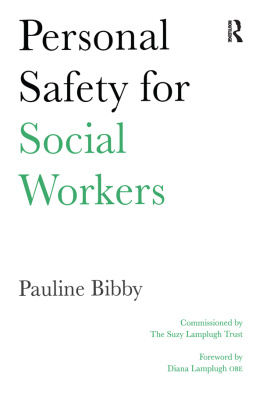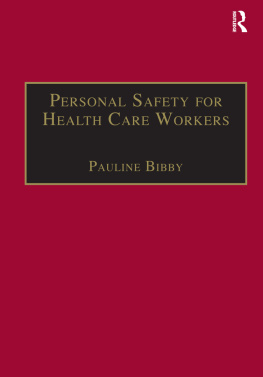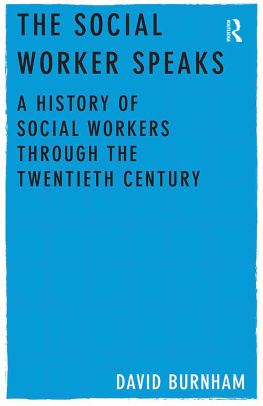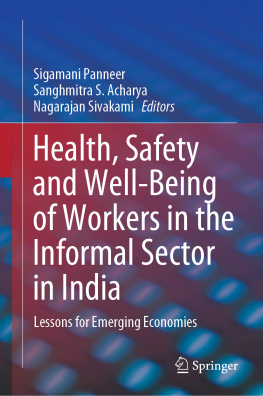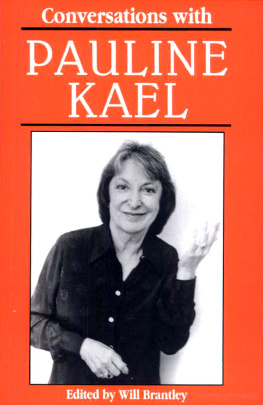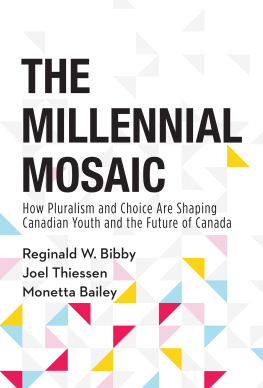First published 1994 by Ashgate Publishing
Published 2017 by Routledge
2 Park Square, Milton Park, Abingdon, Oxon, OX14 4RN
711 Third Avenue, New York, NY 10017, USA
Routledge is an imprint of the Taylor & Francis Group, an informa business
Copyright The Suzy Lamplugh Trust 1994
All rights reserved. No part of this book may be reprinted or reproduced or utilised in any form or by any electronic, mechanical, or other means, now known or hereafter invented, including photocopying and recording, or in any information storage or retrieval system, without permission in writing from the publishers.
Notice:
Product or corporate names may be trademarks or registered trademarks, and are used only for identification and explanation without intent to infringe.
British Library Cataloguing in Publication Data
Personal Safety for Social Workers
I. Bibby, Pauline
361.32
Library of Congress Cataloging-in-Publication Data
Personal safety for social workers/ compiled
and edited by Pauline Bibby; Foreword
by Diana Lamplugh.
p. cm.
Includes bibliographical references.
ISBN 1857421957: 14.95 ($29.50 US: est.)
1. Social workers Great Britain Crimes against.
2. Violence in the workplace Great Britain.
I. Bibby, Pauline, 1937
HV245.P471994
362.88dc20 9417177
CIP
Typeset in l0pt Palatino by Bournemouth Colour Graphics Ltd.
ISBN 13: 978-1-85742-195-8 (pbk)
by Diana Lamplugh OBE
The past year has seemed to us at The Suzy Lamplugh Trust to have been a catalyst. For one thing it has seen the seventh anniversary of my daughters disappearance while at work doing her normal job as an estate agent negotiator. Although she had already been presumed murdered, Suzy could not be declared dead until seven years had passed.
Surprisingly this bleak, though necessary, acknowledgement appears to have become a watershed. As a family, we now feel freer to remember our daughter with joy, although tinged (no longer drowned) by distress. As a Trust, we are freer to progress, and to others we now seem to be a Trust to be trusted.
The Trust was set up in December 1986, and has worked continuously since that time to achieve its aim to empower all people to be able to live safer lives. The Trust was started in order to concentrate on violence against the person in the workplace and continues to do so. Through research, surveys, videos, training manuals, leaflets, books, and conferences, seminars and presentations, the work has been disseminated throughout Britain.
We have always been busy; however, 199394 has seen an unprecedented increase in the demand for the Trusts work and help. It is almost as though employers have suddenly woken up to a problem which has been affecting their employees for some time. In our view, it is not only the strengthening of the law, but also the realization of the problems, the dangers and the obvious fact that employees who are cared for usually work much better, which has proved the trigger. It is now beginning to be recognized that it is cost-effective to look after employees, and that it could also be expensive to neglect them.
In fact, day by day it is becoming more apparent that violence at work is a very real problem. All the indicators point to an increase in violence and also in aggressive incidents and attacks in the workplace or during the course of work. Furthermore, the number of reported incidents is rising. However, until these become a notifiable offence under RIDDOR (Reporting of Injuries, Diseases and Dangerous Occurrences Regulations), they will be impossible to quantify properly.
Why should we think of singling out social workers above all other professions, and how are they different from the rest?
I was travelling by train the other day. Not an unusual occurrence, as I lecture all over the country, and trains are my favourite mode of transport. I can read the newspapers, write articles and above all do tapestry. This is thinking time in peace and quiet. I hardly ever meet anyone I know, but this one time was different. A young man I vaguely recognized stopped and called me by name. He had lived with us as a student many moons ago when Suzy was still with us, and our lives were as yet relatively unchallenged. We chatted about old memories and what we were doing with the Trust.
Youve told me so much I never knew, he said. Im a social worker. I have just been to court twice over cases of aggression and violence. Dealing with psychotic patients, being on your own miles from anywhere, trying to calm down a situation which was getting out of hand. Life sounded more than tough but equally he obviously had no intention of turning away from caring.
This is why The Suzy Lamplugh Trust felt that social workers should be the first to benefit from their own handbook. We had met many groups of social workers from all over Britain when involved with one of the other facets of the Trusts work, concerned with sex offenders and also with our development work on missing people. Listening to their stories and some of the appalling situations social workers can face, we were in no doubt that this was a profession which needed to be given leave to care for their own personal safety. Some social workers are so busy caring for others, they can neglect to care for themselves.
When the publisher asked our advice for someone to write the book using the baseline of our Training for Personal Safety in the Workplace manual, I rang Peter Bibby, who was then Deputy Director of Social Services for Brent. He had told me how and why he had set up his night-time Call Back Service for his social workers, who were used to being accompanied by a policeman on each potentially difficult night-time call. I realized Peter really knew the problems facing his employees.
Peter suggested his wife Pauline, who was not only similarly skilled but also good at writing. Pauline Bibby has proved to be the perfect choice. I gave a draft copy of this book to Liz Potter to read she is a Training Officer in the social services department of an inner London borough. Her comments were:
What can I say? This is an excellent and extremely comprehensive manual dealing with the subject.
As a trainer, I particularly liked the inclusion of training session plans as this would be a very effective means of helping people to absorb what is a considerable amount of information and formulate action plans.
Another very positive feature of this manual is the emphasis that it places on the responsibility of the employing organization and departments to have sound policy and procedures on prevention and dealing with the aftermath of violence to staff, and the important role managers have in supporting individual social workers.
This is particularly important so that individual social workers feel empowered in taking steps to protect themselves, in particular when asking for support or being provided with support where they are undertaking work where there is any doubt at all about their safety and also in having the right to be accompanied by a colleague.


